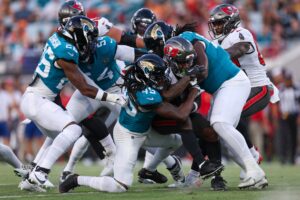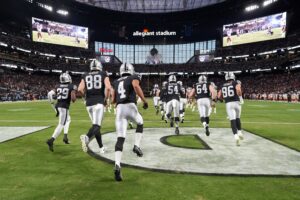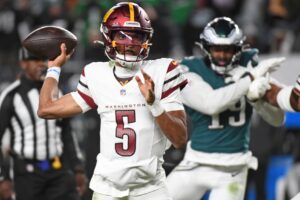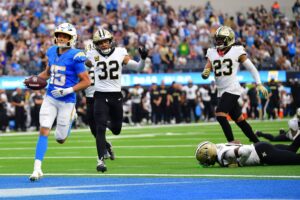During the month of August, the Last Word On Sports NFL department will be breaking down every division in the league by position. This article contains a position-by-position breakdown of the NFC South offenses. The breakdown will contain “the best” at each unit followed by “the rest” in descending order.
2019 NFC South Breakdown by Position: The Offense
Quarterback
The Best: New Orleans Saints
The Rest: Atlanta Falcons, Carolina Panthers, Tampa Bay Buccaneers
Despite turning 40 years of age in January, Drew Brees remains the top quarterback in the NFC South. Entering his 19th NFL season, analysts have argued that the signal-caller is playing the best football of his career. After a “down” 2017 campaign where he only threw for 23 touchdowns (the fewest since 2002), Brees responded with 32 scores to complement his 3,992 passing yards. Though the passing mark was his lowest since 2005, his passer rating (115.7) and completion percentage (74.4) in 2018 were both personal bests. His continued high-end production was a critical reason for him being in the MVP race going into December. The most notable accomplishment for Brees, however, was him breaking the all-time passing yards mark early in the season. Even being outside his physical peak, it can be guaranteed that ninety percent of the league would rather have the 12-time Pro Bowler as their starting quarterback. As it has been since 2006, the Saints will go as far as Brees takes them.
It’s remarkable how quickly the fans and media will forget about a player when they miss the playoffs. Two years removed from claiming the Most Valuable Player award, Matt Ryan has fallen out of the grace of both pundits and viewers, despite posting another spectacular statistical campaign. After an underwhelming 2017 season with 4,095 yards, 20 touchdowns and 12 interceptions, Ryan recovered with 35 scores to only seven picks as he threw for 4,924 yards. The Falcons were riddled with injuries in 2018, but the four-time Pro Bowl passer put forth his greatest season outside of his 2016 MVP run. Going into his 12th season, the former Boston College standout continues to be one of the most consistent players in football, regardless of position. He has reached the NFL All-Star game under three different offensive coordinators, not to mention both of his NFL head coaches, Mike Smith and Dan Quinn, being defensive minds. In an era featuring elite passing productivity, Ryan has quickly become underappreciated.
The team record doesn’t reveal it, but 2018 was a very solid year for Cam Newton. His passing yard (3,395), touchdown (24), interception (13), yards per game (242.5) and passer rating (94.2) marks were all improvements from 2017. His 67.9 completion percentage from last season was even a career best. With Newton’s heightened play, the Panthers were in the thick of postseason contention before their Thursday night debacle against the Pittsburgh Steelers. What’s even more concerning than the team’s collapse down the stretch is the health of the franchise’s greatest quarterback. Although he’s expected to be present Week One, Newton had surgery on his right shoulder back in the spring. It’s no coincidence that the Panthers drafted Will Grier as an insurance policy. If health stays on his side, however, the Panthers should remain competitive.
Concluding a Heisman-winning, national championship-claiming career at Florida State, Jameis Winston was prized as one of the next top-level quarterbacks. After four seasons and zero playoff berths in the pro ranks, time is running out for the 2015 number one overall draft selection. His talent and ability have always been visible, but his off-the-field transgressions and his inconsistency between the sidelines have placed Winston’s tenure as a starting passer in jeopardy. Fortunately, he has Bruce Arians as his new head coach to refine his craft. Thinking optimistically, the coach’s presence should pay dividends for not only Winston but also for wide receiver Mike Evans and tight ends O.J. Howard and Cameron Brate.
Running Back
The Best of the NFC South: New Orleans Saints
The Rest: Atlanta Falcons, Carolina Panthers, Tampa Bay Buccaneers
The New Orleans backfield took a major hit when Mark Ingram signed with the Baltimore Ravens in the off-season. His physicality between the tackles was the perfect match for Alvin Kamara’s flashiness and explosiveness in the open field. Although the “Boom and Zoom” rushing duo is no more in New Orleans, the Saints hope to not miss a beat with veteran Latavius Murray. Drafted in the sixth round of the 2013 NFL draft by the Oakland Raiders, Murray has been a very useful ball-carrier. Starting all 16 games in 2015, Murray earned his only Pro Bowl selection, as he was a central figure for the then-ascending Raiders. His 12 touchdowns in 2016 helped Oakland clinch its first playoff berth since 2002. Compiling 1,420 rushing yards and 14 rushing scores during his two-season stint with the Minnesota Vikings, Murray should be just as productive with Kamara, one of the game’s brightest young stars.
Like New Orleans, the Atlanta Falcons endured a tough blow to their running back room when Tevin Coleman signed with the San Francisco 49ers. The 26-year-old was excellent as the backup to Devonta Freeman as he increased his rushing yardage total each of his four NFL seasons. With Coleman now out west, Freeman will share carries with second-year runner Ito Smith. The fourth-round draftee posted four scores in efforts to replace the absent Freeman. With the healthy return of the team’s Pro Bowl starter, this new tandem can silently be an efficient one throughout 2019.
A heavy-weighted 2017 rookie running back class that featured Alvin Kamara, Kareem Hunt, Leonard Fournette, Joe Mixon and Dalvin Cook had Christian McCaffrey significantly overlooked. Following his quiet, yet respectable, first-year campaign, McCaffrey put together an even better sophomore outing. His 1,097 yards and seven touchdowns on the ground–plus his 867 yards and six scores in the passing game–gave Carolina’s offense a huge boost. With the combination of Cam Newton’s health, a pedestrian receiving corps and tight end Greg Olsen entering his age-34 season, having the former Heisman Trophy finalist available will continue to be imperative for the Panthers.
With every other NFC South franchise having a Pro Bowl rusher, Tampa Bay’s Peyton Barber hasn’t been noticed much. Starting every game for the Bucs last year, Barber finished with 871 yards and five touchdowns on 234 carries. With 2019 being a make-or-break season for Jameis Winston, Barber’s rushing ability could potentially alleviate the pressure of Tampa’s signal-caller. An added workload for Ronald Jones II, also a second-year player, wouldn’t hurt Winston’s case either.
Wide Receiver
The Best of the NFC South: Atlanta Falcons
The Rest: Tampa Bay Buccaneers, New Orleans Saints, Carolina Panthers
The Atlanta Falcons once again reign supreme along the offensive perimeter, and that’s much easier to achieve when Julio Jones is on the roster. After his injury-shortened 2013 campaign, Jones has posted five consecutive seasons with at least 88 receptions and 1,444 receiving yards; in three of those years, he caught over 104 passes. Though he just entered his thirties, he is still playing at an elite, Hall-of-Fame level. Looking in hindsight, it’s crazy to believe that following 2014, he was barely in the conversation with Dez Bryant, Demaryius Thomas and Antonio Brown as the best wide receiver in the sport. Jones is assisted by another pass-catcher from the University of Alabama, Calvin Ridley. Drafted 26th overall, the rookie finished 2018 with 64 catches for 821 yards and 10 touchdowns. Even with this Crimson Tide duo, Atlanta still has Mohamed Sanu to contribute in the passing game. Since his time with the Cincinnati Bengals, Sanu continues to be dependable as caught 64 balls for a career-high 838 yards. With Matt Ryan under center, the Falcons aerial attack will remain a nightmare for defenses.
Though they lost DeSean Jackson this off-season, the Buccaneers still have Mike Evans at their disposal. Coming into the league in 2014, Evans has eclipsed at least 68 receptions and 1,000 yards in each campaign. Career-high marks in yards (1,524) and yards per game (95.3) helped him earn his second Pro Bowl selection. Playing for Tampa Bay and competing against Julio Jones and Michael Thomas within the division, Evans is significantly underrated league-wide. Even more lowkey is Chris Godwin, who finished 2018 with 59 catches for 842 yards and seven touchdowns. With Tampa’s notable tight end tandem of O.J. Howard and Cameron Brate, these wide receivers should have lighter loads against various coverages throughout the upcoming season.
Michael Thomas has emerged as one of the NFL’s premier receivers. Setting both personal and franchise single-season bests in receptions (125) and yards (1,405), it’s clear that Thomas is one of football’s best on the outside. Despite his early-career dominance, New Orleans still needs production from other wideouts. Ted Ginn Jr. is still a valuable deep threat, but he’s 34 years old. Tre’Quan Smith and Keith Kirkwood flashed at points during 2018, but both were mainly inconsistent. Although showing promise during his time with the Chicago Bears, Cameron Meredith could not shake off his injury woes, leading to his release. With an aging Drew Brees and a brand new backfield dynamic, improved performances from the young pass-catchers will be imperative.
The Panthers have yet to replace franchise great Steve Smith at the receiver spot. Kelvin Benjamin momentarily appeared to be the next guy up, but he never committed himself to his craft or his diet. Garnering 788 yards as a rookie, D.J. Moore looks to be promising. Losing Devin Funchess was not ideal, so hopefully for the team Curtis Samuel can take a nice-size leap into year three.
Tight End
The Best of the NFC South: Tampa Bay Buccaneers
The Rest: Atlanta Falcons, New Orleans Saints, Carolina Panthers
Each of the other three NFC South teams boast either a present or former Pro Bowl tight end, but Tampa has the best depth at the position. At 6’6″ and 251 pounds, former Alabama standout O.J. Howard is one of the more promising players the league has to offer. Starting 14 games as a 2017 rookie, he put forth 432 yards and six touchdowns on 26 grabs. Despite only playing 10 games a season ago, Howard recorded personal bests in receptions (34) and yards (565). Complementing him is 27-year-old Cameron Brate, who is a constant chain mover as he has averaged at least 10 yards per reception each season. Notwithstanding a down statistical campaign in 2018, Brate caught six touchdowns passes for the second straight year.
Although New Orleans and Carolina have proven veterans at the position, Atlanta edges them out due to age. A third-round draft selection in 2016, Austin Hooper is yet another emerging tight end in the NFL. Starting only three games as a rookie, Hooper put forth 526 yards and three touchdowns on 49 catches in 2017. Last season, he set career highs in receptions (71), yards (660) and touchdowns (four) in only seven starts. Though his numbers say otherwise, Hooper may arguably be the most unnoticed Pro Bowler. With Julio Jones, Calvin Ridley, and Mohamed Sanu as teammates, passing lanes will continue to open up for the 24-year-old.
After four seasons of a revolving door, New Orleans has found its star tight end. At age 32, veteran pass-catcher Jared Cook is coming off his best season as a professional. Playing in the midst of an underachieving Raiders team, Cook finished 2018 with 68 receptions for 896 yards and six touchdowns. With Drew Brees passing him the football and Michael Thomas occupying extra defenders, Cook should have no issue contributing at a high level; he can even make Sundays much lighter for the likes of Tre’Quan Smith and Keith Kirkwood. The 11-year pro may not produce at the level of prime Jimmy Graham, but the Saints offense will be a strong fit for the seam surgeon.
Greg Olsen is the perfect example of an NFL “late bloomer.” After a decent tenure with Chicago to begin his career, Olsen became one of the league’s top tight ends in Carolina. From 2012-2016, he posted at least 69 catches and 816 yards each year, including three straight seasons of at least 77 receptions. Injuries have derailed each of his last two campaigns, which is why the Panthers place last in this tight end category for the division. At age 34, it’ll be intriguing to see if Olsen can return to his 2016 form. Him remaining healthy will be crucial to Carolina’s offensive approach.
Offensive Line
The Best of the NFC South: New Orleans Saints
The Rest: Carolina Panthers, Atlanta Falcons, Tampa Bay Buccaneers
Ranking sixth in rushing and surrendering the second-fewest sacks in football (20) during 2018, the Saints offensive line is still the division’s best. When active, Terron Armstead is one of the game’s elite left tackles. Beginning his career with the Detroit Lions, right guard Larry Warford has made two consecutive Pro Bowls. Stanford product Andrus Peat has established himself as an all-star guard after starting his NFL days as a tackle. Though he didn’t make it to Orlando, Ryan Ramczyk earned Second-team All-Pro honors as a right tackle last year. The Saints did lose Pro Bowl center Max Unger to retirement, but rookie Erik McCoy was a solid pickup in round two of the draft.
This unit doesn’t receive the national attention, but Carolina’s offensive front performed well a year ago. The 32 sacks they allowed were the seventh fewest league-wide, and their 133.5 yards per game average on the ground placed fourth overall. Making four consecutive Pro Bowls, Trai Turner is one of the NFL’s most dependable interior linemen. Taken in the second round of the 2017 draft, Taylor Moton ranked as the 16th-best left tackle by analytics site Pro Football Focus. The signing of center Matt Paradis from the Denver Broncos was a massive addition for the Panthers. Keeping defenders off of Cam Newton’s hampered body will be a win for this front five every single week.
Even with the help of two Pro Bowl blockers, the Atlanta Falcons offensive line was subpar in 2018, allowing 42 takedowns on Matt Ryan. The team’s ground game didn’t impress either, placing 27th overall in rushing offense. Though the team endured numerous injuries, including in the backfield, a less-talented front on paper in Carolina was simply better last season. Atlanta did have the third-most 40-yard rushes in 2018, but that type of output is never truly sustainable for the duration of a campaign. Behind the guidance of Alex Mack and Jake Matthews and the additions of a pair of first-round rookies, the line should be able to rebound in 2019.
Even though the group gave up one sack fewer than the Falcons, the Buccaneers front five placed 29th in rushing for the 2018 season. What separates the Falcons line from the Bucs is that they have more high-end potential with their two Pro Bowl contributors. Ali Marpet still remains one of the game’s most underrated blockers. Donovan Smith and Demar Dotson make up a veteran tackle tandem, but Pro Football Focus grades in the 60 range are not encouraging. Ryan Jensen and Alex Cappa must also improve their play in order for Tampa Bay to be successful offensively in 2019.
Check out the NFC South defensive breakdown.
NFC South Main Photo:
Embed from Getty Images






